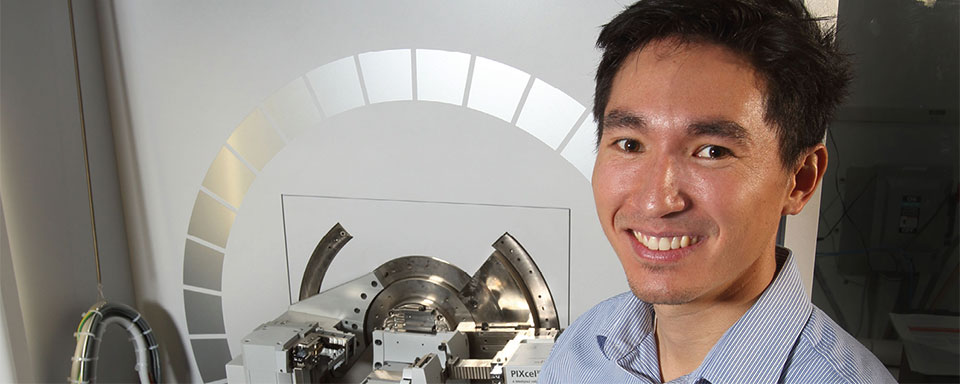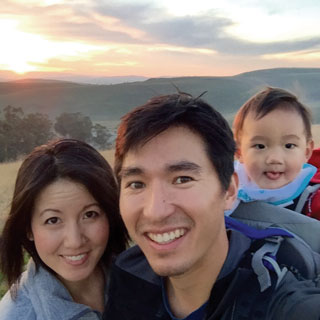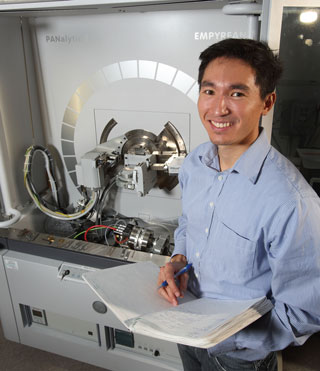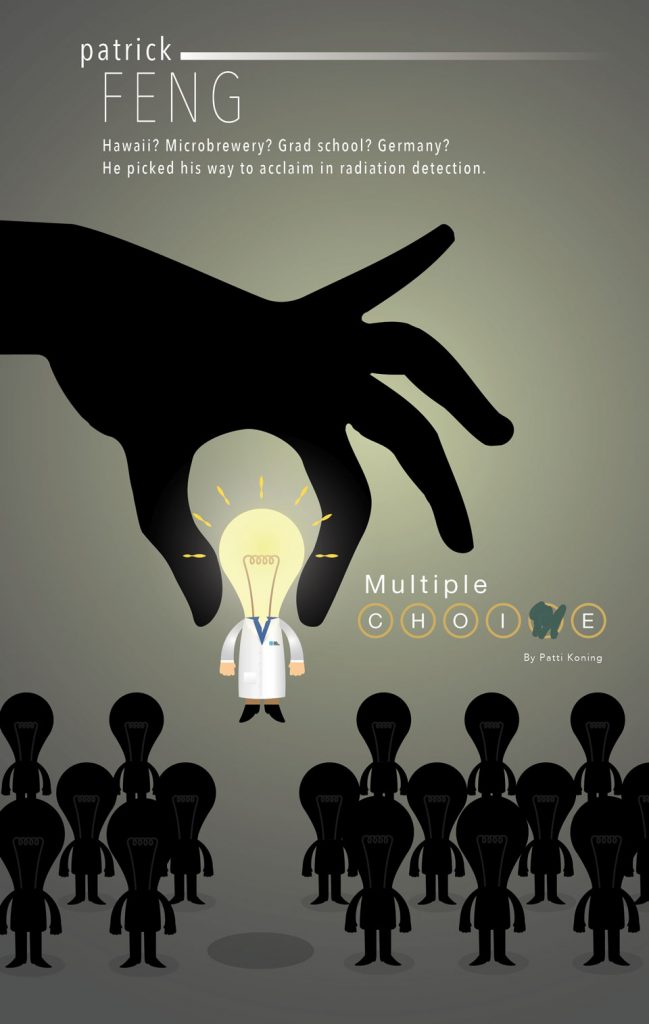Hawaii? Microbrewery? Grad school? Germany? Patrick Feng picked his way to acclaim in radiation detection.


Patrick Feng can map his professional success to a series of decisions that led him to Sandia. That path began as a high school student in Hawaii.
Until his senior year, Feng had planned to study electrical engineering in college. “I was involved in extracurricular activities like circuit design competitions and electronics club, but then I discovered synthetic chemistry,” he says. “The idea that you could create something wholly new, that would not otherwise exist in nature — that was fascinating.”
His high school chemistry teacher taught labs like sol-gel growth of large organometallic crystals, which exposed Feng to the possibilities of chemistry. When it came time to fill out his college applications, Feng had decided to major in chemistry.
Growing up on the island of Hawaii, Feng said he wanted to go anyplace else for college. “I really took for granted the natural beauty and wonders of Hawaii,” he says. “Now I appreciate what a special place it is.” He chose Colorado State University without ever setting foot in the state.
Research tipped the scales

Another key decision came when he finished his undergraduate degree. As a student, Feng received a partial research scholarship from the Hach Company, a manufacturer of water testing and analysis equipment used in Colorado’s many microbreweries. “I had an opportunity to work as a chemist in a microbrewery, which would have been a cool job,” says Feng. “But the research opportunities I’d had as an undergraduate really tipped the scales for me in favor of graduate school.”
Feng was then faced with two more critical choices. He decided to attend graduate school at the University of California at San Diego, turning down offers from Stanford and the University of Washington. He and his college girlfriend, who remained in Colorado, chose to give a long-distance relationship a try. “We married in 2014 after she moved to Livermore. Her finance job in Colorado was downsized, which was the perfect opportunity for us to finally live in the same city again,” says Feng. He and Sophia now have a 2-year-old son, Kai.
Just two years into graduate school, Feng’s adviser left for a position in Germany. With the alternatives of following the professor to Germany or restarting his research, Feng opted to remain in San Diego. He began a new research project on molecular magnetism under a different professor.
“What at first appeared to be a major setback, I now think set me up for later success,” says Feng. He quickly became passionate about molecular magnetism and matured both academically and professionally through the experience of working under two very distinct advisers. “My advisers had very different styles. One was very hands-on and another one hands-off. I learned to appreciate the pros and cons of academic freedom, particularly during those formative years, “ he says.
After completing his doctorate, Feng sought out opportunities for work that would have practical applications. He landed at Sandia in 2009 as a postdoctoral student working under Mark Allendorf. “Mark ran his projects in an academic style,” says Feng. “His style fell right between that of my two graduate advisers. He gave me just enough structure while still keeping research open-ended.”
Most Promising Engineer

What came next for Feng was a series of high-profile projects. As a postdoc, he worked on Patrick Doty’s project, “Use of Metal Organic Fluors for Spectral Discrimination of Neutrons and Gammas.” The Laboratory Directed Research and Development (LDRD) project looked at organic scintillators in different testbeds including plastics, oils and a relatively new class of materials, metal organic frameworks, or MOFs.
After becoming a member of the technical staff at Sandia, Feng was made the principal investigator on a National Nuclear Security Administration-funded project to further develop plastic scintillators. That technology, Triplet-Harvesting Plastic Scintillators, went on to win an R&D 100 award in 2014. That year Feng also won an Asian American Engineer of the Year award, Most Promising Engineer.
He’s now leading a project, which began as an Early Career LDRD and has follow-on funding, examining how to modify crystalline materials to achieve a given goal. “It’s a first-principles approach to solving technological problems,” says Feng. “Usually this is done with a physics approach.” The goal is to develop a class of materials that can be used for radiation detection in the field. “I find this work extremely satisfying because it is basic research with an eye to a path to commercialization and large scale impact,” says Feng. “I think we will achieve success during my tenure at Sandia.”
Despite his busy career at Sandia, Feng finds plenty of time for mentoring. He has one postdoc and two year-round undergraduate students. He has mentored seven undergraduate students during the past six years. “Mentoring reenergizes my outlook on science. Young scientists still have the excitement of discovery that is sometimes tempered in those of us who have been doing research longer,” Feng says.
He also finds satisfaction in making a tangible impact on the future of young researchers. “This is particularly true when I hear about the success that some of my interns have in their academic and professional careers. I enjoy being able to see the development of these individuals as scientists, even over relatively short timescales such as an academic year or even a summer.”
Symmetry
PSymmetry, the correspondence in size, form and arrangement of parts on opposite sides of a plane, line or point, is also defined as “excellence in proportion” in creating beauty. In nature, symmetry does more than make features pleasing to the eye – it also impacts many phenomena encountered in everyday life. It is remarkable how many diverse properties are defined simply by the arrangement of things in space.

For example, fundamental material properties such as thermal and electrical conductivity, magnetic permeability and nonlinear optical effects are intimately associated with the geometric arrangement of constituent atoms or molecules in a material.
These relationships between structure and property have factored into several of Patrick Feng’s research projects. In one project to improve the efficacy of radiation detection materials, his team prepared rotational threefold symmetric versions of fluorescent organic molecular crystals used in such an application to improve their radiation-induced luminescence signature. In other words, the highly symmetric crystalline lattices were found to provide improved discrimination of threat materials against benign background radiation. In this case, the symmetry of the lattice controls the physics of light production and the mechanical strength of the material, in ways that improve the radiation detection performance of preceding materials.